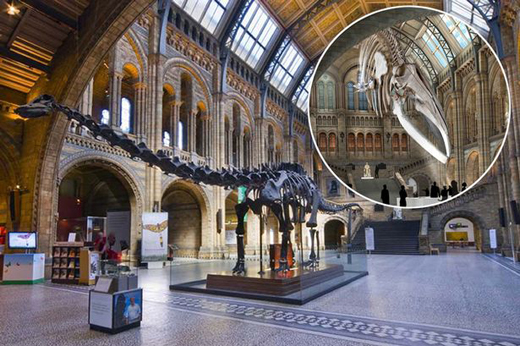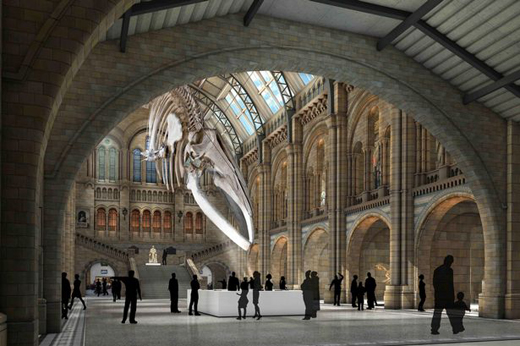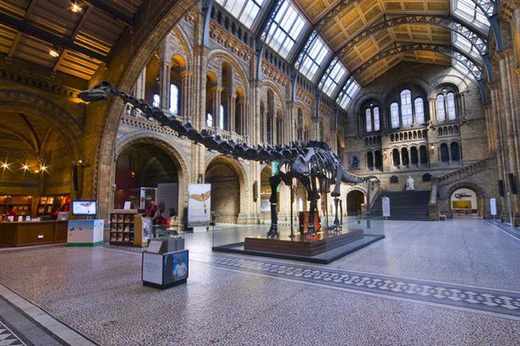Dinosaur forced to RETIRE from the Natural History Museum as it’s ’not relevant’
Dinosaur forced to RETIRE from the Natural History Museum as it’s ’not relevant’
Mangalore Today News Network
London, Jan 29, 2015: The plaster dinosaur skeleton has inspired generations of schoolchildren at the London museum for 109 years. Retired: Dippy the dinosaur
Retired: Dippy the dinosaur
An icon of the Natural History Museum is being forced to retire.
Dippy the Diplodocus, which has inspired generations of schoolchildren, is to be moved out of the museum’s main hall.
The plaster dinosaur skeleton has been a fixture of the London museum for 109 years but is not considered relevant enough to what is happening to the natural world today.
So from summer 2017, he will be replaced by the 83 foot long (25.2 metres) real skeleton of a blue whale, suspended and "diving" from the ceiling of the Hintze Hall.
The whale, previously the centrepiece of the Mammal Hall, is said to serve as a potent symbol of both environmental destruction and hope for the future.
Meanwhile, there are plans to preserve Dippy at least for a while, possibly by sending him on a tour of the UK.
Despite his realistic appearance, Dippy is a fake - an exact plaster cast copy of an 85 foot long (26 metres) diplodocus, a giant four-legged sauropod dinosaur that lived in North America 150 million years ago.
New exhibit: How the blue whale could look
Originally installed in the Reptile Gallery in 1905, he was taken apart and stored in the Natural History Museum’s basement to avoid damage during the Blitz.
In 1979, he was rebuilt and given pride of place in the central hall.
For the last 35 years, Dippy has greeted visitors filing through the museum’s main entrance.
The change is part of a "decade of transformation" planned at the museum by its director, Sir Michael Dixon.
Explaining the decision, Sir Michael said: "As the largest known animal to have ever lived on Earth, the story of the blue whale reminds us of the scale of our responsibility to the planet.
"This makes it the perfect choice of specimen to welcome and capture the imagination of our visitors, as well as marking a major transformation of the Museum.
"This is an important and necessary change.
"As guardians of one of the world’s greatest scientific resources, our purpose is to challenge the way people think about the natural world, and that goal has never been more urgent.
"The very resources on which modern society relies are under threat. Inspiring generations: Dippy the Diplodocus
Inspiring generations: Dippy the Diplodocus
"Species and ecosystems are being destroyed faster than we can describe them or even understand their significance.
"The blue whale serves as a poignant reminder that while abundance is no guarantee of survival, through our choices, we can make a real difference.
"There is hope."
The female blue whale has been a resident at the Natural History Museum for longer than Dippy, arriving in 1891, just 10 years after the museum opened.
It was found beached at the mouth of Wexford Habour on March 25 1891, after being injured by a whaler.
In the same year, the skeleton was bought for £250 from a Wexford merchant, to become part of the museum collection.
But the specimen only went on public display in 1938 with the opening of the Mammal Hall, where it is currently suspended over a life-size blue whale model.
Blue whales were hunted to near extinction for their oil, meat and body parts before starting to recover their numbers after being granted protected status.
Courtesy: Mirror
- Karnataka government focusing on harnessing more solar power, says Energy Minister
- Pedestrian fatally run over by tanker at Kulur
- Karkala: Forest fire engulfs vast tracts of land
- Maintenance works in Palakkad division; changes in train services
- Udupi: Bike-tipper collision claims rider’s life
- Kadaba acid attack victim writes CET in Mangaluru
- EC dismisses concerns as Kasaragod mock poll sparks row
- Malpe: 3 tourists washed away by strong tidal waves; 2 rescued; 1 drowns
- IMD predicts rain, thunderstorms across Karnataka for next 3 days
- WhatsApp will soon let you see which of your friends were recently online
- Kasaragod: SC asks EC to check reports of EVMs registering ‘extra votes’ for BJP in mock polls
- Elect a representative who works for you, Hegde tells voters
- St Joachim church Kadaba, commemorated its Centenary celebration on April 17
- World Liver Day 2024: These factors might worsen your liver health
- World Heritage Day 2024: Theme, history, significance, and top 5 heritage sites in India
- How science will get Sun to kiss Ram Lalla’s forehead on Ram Navami
- Artist’s sweet gesture towards waiter impresses the Internet, Watch
- Children addicted to video games, smartphones at risk of Psychosis: Study
- This story of an ailing elephant and her calf will move you to tears
- Listen to your body: 5 types of pain signalling heart issues
- Eid ul-Fitr: Why it is celebrated and other things to know
- 10 Health benefits of avoiding Sugar completely
- Ugadi 2024: A look at the importance of this festival in Karnataka
- Total Solar eclipse 2024: Do’s and don’ts to follow during the eclipse
- Common household chemicals could harm brain development, study suggests
- Frightening video of Strawberry under Microscope shocks Internet, Watch
- "Are we in Pak or Afghanistan?" Actor, husband attacked by mob in Bengaluru
- Air India suspends flights to Tel Aviv till April 30 amid Iran-Israel clash
- H5N1 strain of bird flu found in raw milk from infected animals: WHO
- Not love jihad: Karnataka govt amid outrage over woman’s murder in college
- Indian embassy advises Indians to reschedule non-essential travel as UAE reels under historic floods
- Almost 0% voting in 6 Nagaland districts over separate territory demand
- Amit Shah files nomination from Gandhinagar: ’Rose from booth worker to MP’
- Supreme Court’s big order on voter awareness rallies amid prohibitory orders
- Elon Musk’s message of peace amid Israel-Iran tensions: ’Send rockets to stars’
- Rajinikanth, Kamal Haasan, Dhanush, Vijay Sethupathi vote in Chennai
- Vice Admiral Dinesh Tripathi appointed as next Indian Navy chief
- Iran shoots down several drones, US officials suspect Israel: 10 points
- CITY INFORMATION
- TRAVEL
- TOURIST INFORMATION
- HEALTH CARE
- MISCELLANEOUS




 Write Comment
Write Comment E-Mail
E-Mail Facebook
Facebook Twitter
Twitter  Print
Print 

